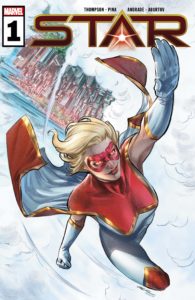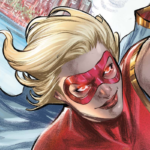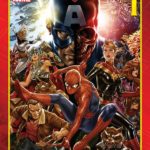 Writer: Kelly Thompson
Writer: Kelly Thompson
Artist: Javier Pina with Filipe Andrade
Colorist: Jesus Aburtov
Letters: VC’S Clayton Cowles
Cover Art: Carmen Carnero and Jesus Aburtov
Editor: Sarah Brunstad
Publisher: Marvel Comics
Shooting from the pages of Captain Marvel, Ripley Ryan makes her solo debut in this week’s Star #1, and the jury’s still out on whether that’s a good thing for the Marvel Universe.
Ripley’s arrival came with an unusual amount of fanfare for a new (non-legacy) character, with her debut issue as Star becoming a hot item among speculators. In any event, Riley proved to be an interesting antagonist for Captain Marvel enough that she’s headlining her own limited series, written by co-creator Kelly Thompson. Now that she’s on her own, does she have what it takes to emerge as Marvel’s next great anti-hero?
Ripley’s origin in the pages of Captain Marvel was pretty standard superhero stuff. She was a mild-mannered reporter who came into the possession of super-powers … except in her case, they came courtesy of mad scientist Minn-Erva as part of a larger scheme to recruit Carol Danvers to the Kree army (Ripley’s powers were siphoning straight from Carol herself in a Rogue-esque manner). After learning she was used by a super-villain, Ripley nearly killed Minn-Erva and almost took Carol down too, but ended up with a literal hole in her chest from the Captain. She should have died. Instead, she woke with the Reality Stone somehow inside her, effectively giving Ripley all the immense powers that came with it (I’m not sure if this is a riff on Carol’s MCU origin, where she’s given her powers by the Space Stone, but it feels pretty on-the-nose for it to be a coincidence).
When we first see Riley in Star, she’s still struggling with the revelation that she’s a living Infinity Stone. A lonely night out at the (Pop-Up) Bar With No Name quickly devolves into typical super-person shenanigans that takes Ripley on a tour of some of the Marvel Universe’s heaviest hitters, embroiling her into what could be a multiversal crisis. In other words, a typical day in the MU.
As written by Thompson, Ripley is very obviously still in a flux state as a character, and this issue does some work to cement who she is, but there’s still a big question mark over her head. She’s much more subdued and less frantic here than she was in her introductory arc, but you could easily figure that she was driven mad by Minn-Erva’s experimentation, and that the Ripley we see now is closer to who she was before. That’s possibly by design; not being able to pin down her motivations just yet could be a source of suspense throughout this series. Now that she has all this power inside her, what will she do with it? Does being the bad guy once mean she’ll always be bad, or is she going to work through some redemption measures instead?
Star has the zippy plotting we’ve come to expect from Thompson as a writer, even if her protagonist hasn’t really emerged from the initial sketching phase just yet. As a new player in the Marvel Universe, she’s put through her paces with fun cameos from familiar faces, and Thompson is successful in giving the reader an opening to empathize with Ripley’s ambiguity. Whether she turns out to be friend, foe, or somewhere in between, I’m definitely interested to see where she goes with this story.
Javier Pina’s art is another asset for the book, with clean lines accentuated by colorist Jesus Aburtov’s moody palette (Captain Marvel veteran Filipe Andrade also contributes a flashback page, and I’m always happy to see his art). Pina’s illustrations are very in-keeping with the aesthetic of Star’s co-creator Carmen Carnero, which lends an appreciative sense of visual continuity for the character. I do wonder if Ripley’s look will get an overhaul at some point, however, because she doesn’t look completely indistinct from both Carol and her Captain Marvel getup. If you didn’t know this wasn’t Captain Marvel, you wouldn’t be wrong for conflating the two. But that remains to be seen.




